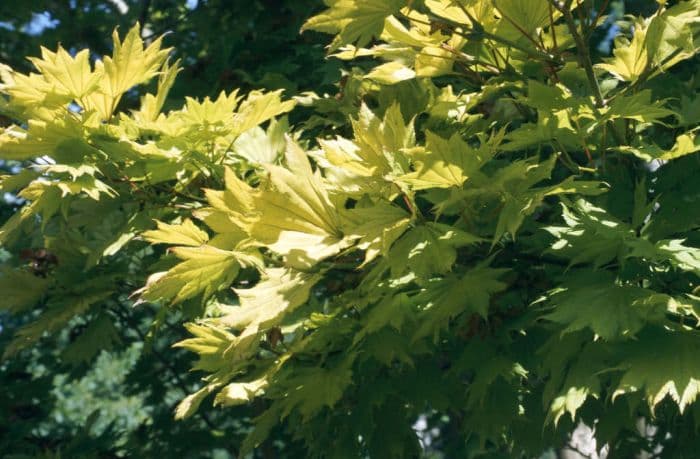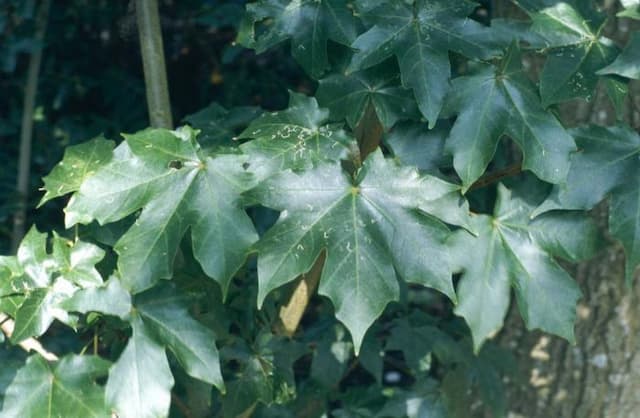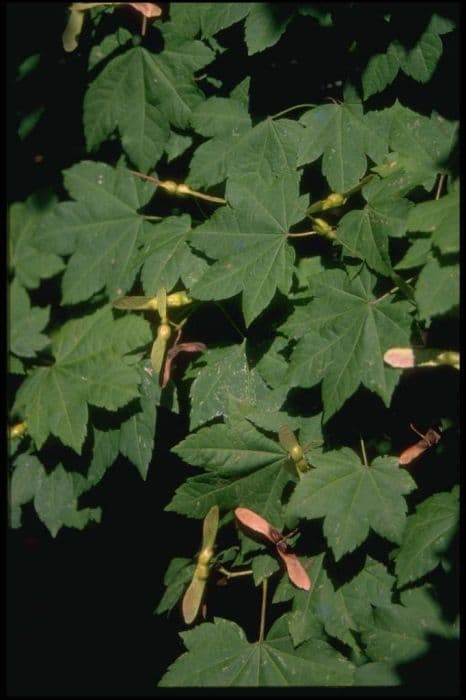Golden Full Moon Maple Acer shirasawanum 'Aureum'

ABOUT
The Acer shirasawanum 'Aureum', commonly known as the Golden Full Moon Maple, is a highly decorative plant known for its uniquely colored leaves and aesthetically pleasing shape. Its leaves are the most striking feature, showcasing a round and almost palmate structure, reminiscent of a full moon. These leaves hold a delicate and unusual golden-yellow hue, with a soft, almost pastel undertone. Throughout the different seasons, the leaves undergo a captivating transformation; they often emerge in spring with a brighter intensity of yellow, and as the months pass, the foliage can take on shades of lime green, especially if the tree is grown in a location with more shade. During autumn, the Golden Full Moon Maple puts on another display of color, when the leaves develop rich, warm tones varying from orange to red, creating a striking contrast against the cooler landscape. The bark of this plant is smooth and a grayish-brown color that provides a subtle backdrop to the vibrant leaves. The branches extend outwards, forming a canopy that contributes to the plant's overall graceful appearance. The tree blooms in the spring with small, attractive flowers that typically go unnoticed amidst the stunning foliage. These flowers may develop into winged seeds often referred to as "samaras," which dangle from the branches and add an extra dimension of texture and interest to the tree. The structure of the Golden Full Moon Maple is well-balanced, giving the plant a harmonious and pleasing symmetry that makes it an exquisite addition to any landscape where it serves as a focal point, particularly during its peak seasons of spring and fall when its foliage is most vibrant.
About this plant
 Names
NamesFamily
Sapindaceae
Synonyms
Golden Full Moon Maple, Golden Leaf Japanese Maple, Aureum Japanese Maple
Common names
Acer shirasawanum 'Aureum'.
 Toxicity
ToxicityTo humans
The Acer shirasawanum 'Aureum', commonly known as Golden Full Moon Maple, is not known to be toxic to humans. There are no commonly reported symptoms of poisoning because it is generally considered non-poisonous. Therefore, ingesting parts of this plant is unlikely to lead to toxic consequences. However, it's always prudent to avoid eating plant parts that are not known to be edible or that have not been properly prepared for consumption.
To pets
The Golden Full Moon Maple is also not known to be toxic to pets. It is not listed among the plants that are harmful to dogs, cats, or other animals commonly kept as pets. As such, there are no expected symptoms of poisoning from this plant, and ingesting parts of it is unlikely to cause harm. Nevertheless, it is always best to prevent pets from ingesting plants that are not intended for consumption, as they could potentially cause gastrointestinal upset or other non-toxic related issues.
 Characteristics
CharacteristicsLife cycle
Perennials
Foliage type
Deciduous
Color of leaves
Golden
Flower color
Purplish-red
Height
15-25 feet (4.5-7.6 meters)
Spread
15-25 feet (4.5-7.6 meters)
Plant type
Tree
Hardiness zones
5
Native area
Japan
Benefits
 General Benefits
General Benefits- Ornamental Value: The 'Aureum' variety, known commonly as Golden Full Moon Maple, has striking yellow to lime-green foliage, which provides a unique color contrast in gardens and landscapes.
- Seasonal Interest: Throughout the seasons, the Golden Full Moon Maple displays a variety of colors — its leaves turn striking shades of red and orange in autumn, enhancing the visual appeal of the area where it's planted.
- Shade Provision: With its broad canopy, the Acer shirasawanum 'Aureum' offers a cool, shaded area in gardens and parks, creating a comfortable space for relaxation and outdoor activities.
- Wildlife Attraction: The tree provides habitat and food for various species of birds and insects, which can benefit local biodiversity.
- Low Maintenance: Once established, the Golden Full Moon Maple requires minimal care, making it a suitable choice for both novice and experienced gardeners.
- Compact Size: Its relatively small stature allows Acer shirasawanum 'Aureum' to fit into smaller gardens or landscapes where space might be limited, without the risk of it overpowering the area.
- Cultural Significance: The Japanese heritage of the Golden Full Moon Maple gives it cultural significance, and it is often used in traditional Japanese gardens.
 Medical Properties
Medical PropertiesThis plant is not used for medical purposes.
 Air-purifying Qualities
Air-purifying QualitiesThis plant is not specifically known for air purifying qualities.
 Other Uses
Other Uses```html
- Bonsai Artistry: Acer shirasawanum 'Aureum', commonly known as the Golden Full Moon Maple, is a favored species among bonsai enthusiasts for its vibrant foliage and graceful structure, allowing for the creation of miniature landscapes.
- Photography Prop: Photographers may utilise the striking leaves of the Golden Full Moon Maple as a backdrop or focus in portraiture and macro photography to add depth and natural beauty to their compositions.
- Aquascaping: The fallen leaves of the Golden Full Moon Maple can be used in aquariums to create naturalistic habitats for fish and invertebrates, as they release beneficial tannins into the water.
- Leaf Casts: Crafting enthusiasts can create detailed leaf casts using the leaves from the Golden Full Moon Maple as molds to capture the unique shape and vein patterns in plaster or other casting materials.
- Seasonal Decorations: The colorful autumn leaves of the Golden Full Moon Maple can be preserved and used in wreaths, table displays, and other fall-themed decorations to celebrate the season.
- Artistic Inspiration: Artists may find inspiration in the beautiful colors and forms of the Golden Full Moon Maple for paintings, illustrations, and other visual art projects.
- Educational Tool: Teachers can use the distinct leaf shapes and color transitions of the Golden Full Moon Maple to educate students about plant identification, photosynthesis, and seasonal changes in plants.
- Landscaping Contrast: Due to its vibrant yellow leaves, the Golden Full Moon Maple can be strategically planted in landscapes to create eye-catching contrast with darker foliage plants.
- Wildlife Shelter: Although not typical, the dense canopy and branching of the Golden Full Moon Maple can provide shelter and nesting spots for small birds and other wildlife in a garden setting.
- Shade Provider: The broad canopy of the Golden Full Moon Maple can be used to provide shade in ornamental gardens or for delicate plants that do not tolerate direct sunlight well.
Interesting Facts
 Feng Shui
Feng ShuiThe Japanese Maple is not used in Feng Shui practice.
 Zodiac Sign Compitability
Zodiac Sign CompitabilityThe Japanese Maple is not used in astrology practice.
 Plant Symbolism
Plant Symbolism- Change: The Acer shirasawanum 'Aureum', commonly known as the Golden Full Moon Maple, often symbolizes change due to its leaves that transform in color throughout the seasons.
- Peace: The smooth edges and rounded shape of its leaves can evoke a sense of calm and tranquility, leading it to be associated with peace.
- Harmony: The balanced and symmetrical growth habit of the Golden Full Moon Maple is indicative of harmony, making it a symbol of balance in life.
- Endurance: As a hardy plant that experiences change and yet remains strong, it often represents endurance and the ability to persist through various challenges.
- Beauty: With its stunning golden foliage that shines brightly in the garden, the Golden Full Moon Maple is also emblematic of beauty and uniqueness.
- Japan: As a species native to Japan, it can represent the country and its culture, including an appreciation of nature's beauty and seasonal changes.
 Water
WaterThe Golden Full Moon Maple should be watered deeply once a week, providing approximately 1.5 to 2 gallons of water for smaller trees, and for larger specimens, around 4 gallons may be more appropriate, depending on the size and weather conditions. During hot or dry periods, it may require water twice a week. Water the soil directly, avoiding wetting the leaves to prevent fungal diseases. It's essential to ensure that the soil is moist but not waterlogged, as this species does not tolerate standing water.
 Light
LightGolden Full Moon Maples thrive in partial shade to full sun, but they prefer a location that shields them from the harsh afternoon sun. The ideal spot for this plant would provide morning sunlight with dappled shade in the afternoon. This lighting condition helps to protect the delicate leaves from scorching and promotes vibrant leaf coloration.
 Temperature
TemperatureThe Golden Full Moon Maple fares best in temperatures ranging from 20°F in the winter to 80°F in the summer. The plant can survive minimum temperatures down to -20°F but is at risk of frost damage at those extremes. Ideal growing conditions involve consistent temperatures that do not fluctuate rapidly, avoiding both prolonged heat and severe cold spells.
 Pruning
PruningPruning the Golden Full Moon Maple should be done to remove dead or damaged limbs, maintain shape, and enhance airflow within the canopy. The best time to prune is in late winter or early spring before new growth starts. Prune sparingly, as heavy pruning can stimulate excessive growth, and be sure to make clean cuts close to the branch collar. It is usually not necessary to prune every year; inspect the tree annually and prune as needed.
 Cleaning
CleaningAs needed
 Soil
SoilGolden Full Moon Maple thrives best in well-draining soil with a mix of one-third peat, one-third pine bark, and one-third coarse sand or perlite; a pH between 5.5 and 6.5 is ideal for optimal growth and foliage color.
 Repotting
RepottingGolden Full Moon Maples should be repotted every 2 to 3 years to replenish soil and encourage healthy root growth; the repotting process helps prevent root-bound conditions and maintains plant vigor.
 Humidity & Misting
Humidity & MistingGolden Full Moon Maple prefers a humidity level of around 50-60%; it tolerates some variation in humidity, but too dry conditions may lead to leaf scorch, especially in windy locations.
 Suitable locations
Suitable locationsIndoor
Place near bright, indirect light and keep slightly moist.
Outdoor
Plant in dappled shade, shelter from strong winds.
Hardiness zone
5-7 USDA
 Life cycle
Life cycleGolden Full Moon Maple (Acer shirasawanum 'Aureum') begins its life cycle from seed, which after stratification, germinates in spring. The young sapling emerges, developing a primary root and sprouting its first set of true leaves, adapting to the local conditions. As it grows into a young tree, it undergoes a period of rapid vegetative growth, producing its characteristic golden-yellow, palmate leaves. Over the years, it matures and begins its reproductive phase, flowering in early spring; the inconspicuous red or purple flowers give way to the development of samaras, the winged fruit, which disperse in late summer or fall. The mature tree enters a phase of maintenance, where growth slows; it reaches a mature height of 15-25 feet and can live for several decades, contributing to the local ecosystem before eventually senescing. Throughout its life cycle, the Golden Full Moon Maple experiences seasonal changes, losing its leaves in the fall and entering dormancy during the winter months.
 Propogation
PropogationPropogation time
Early spring
The Golden Full Moon Maple, scientifically known as Acer shirasawanum 'Aureum', is commonly propagated using the grafting method. This approach, favored due to its reliability in replicating the desirable characteristics of the parent plant, involves taking a stem section with a bud from the Golden Full Moon Maple and attaching it to a rootstock of another maple species. The best time to carry out this process is in late winter, just before spring growth begins. The scion, or the cutting to be grafted, should be from the last season’s growth and should be around 2 to 6 inches (5 to 15 centimeters) long. It is carefully spliced with a similarly sized section of the rootstock, ensuring a good cambial alignment. The union is then wrapped and sealed with grafting tape or compound to prevent dehydration and infection. The grafted plant is kept under favorable conditions to encourage the graft to take, a process that may take several weeks.





![Freeman maple [Autumn Blaze]](/_next/image?url=https%3A%2F%2Fplants-admin.emdemapps.com%2Fimages%2Fplants%2F%2Fimages%2F604b575b84d87.png&w=640&q=75)



